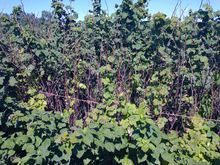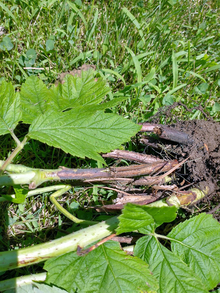The most common raspberry diseases in Minnesota are botrytis fruit rot, cane blights, phytophthora crown and root rot, and powdery mildew.
All growers should use cultural management practices to prevent disease, and only apply fungicides if necessary. In years with little rainfall, some farms may go an entire season without spraying fungicides for raspberries. They can become especially prone to diseases when they are grown in a very wet, humid environment and during years with frequent rainfall.
General cultural strategies include:
- Remove dead or diseased canes.
- Prune each winter or spring to maintain narrow rows.
- Manage weeds and mowing.
- If possible, grow raspberries in high tunnels instead of in the open field.
- Use drip irrigation instead of overhead irrigation.
- Time irrigation carefully so that the soil is moist but not consistently wet.
- Plant in well-drained soil.
- If the soil is very heavy, form raised beds for new plantings.
- Use hand tools carefully, so as not to physically injure the canes.
- Use clean tools and clothing, to minimize transmission of disease-infected soil from other parts of the farm.
- For summer-bearing raspberries only: Train the floricanes to one side of the trellis and primocanes to another, to open the canopy.
Raspberries grown in open fields experience more disease problems than high tunnel raspberries. Rainfall and overhead watering promote leaf and fruit diseases. In high tunnels, growers can largely prevent disease through good cultural management practices and by using drip irrigation.
When you suspect a disease, contact your local or state Extension fruit specialist, who may suggest submitting a sample to a plant disease clinic for diagnosis.
Botrytis fruit rot (Gray mold)
Botrytis (Botrytis cinerea) is one of the most common and serious diseases of raspberries worldwide. Symptoms include gray mold formation on the fruit, rendering the fruit inedible.
It spreads with rainfall or overhead irrigation and is favored in cool, moist environments. Because of this, it is less common in high tunnels with drip irrigation. However, it can potentially occur in very humid tunnels if the spores blow in from outside.
- Botrytis infects plants during bloom and then develops gray mold on ripe fruit either before harvest or during storage.
- Since the spores infect weeds and spread by wind, keep the area as weed-free as possible.
- Maintain ventilation in the high tunnel or field to lower the humidity.
Fungicides: Only use fungicides for botrytis if necessary; they may not be necessary every season. Organic and conventional fungicides are available for botrytis and they vary in efficacy. Apply the first application during bloom. If needed based on rainfall, visual symptoms, or past infection history, make another application. Subsequent applications can be made through harvest at 14 day intervals.
Refer to the Midwest Fruit Pest Management Guide for fungicide recommendations.
Phytophthora root and crown rot
The pathogens that cause this disease are common in the soil. They require wet, heavy soil or standing water to become pathogenic. Phytophthora infects the crown (base) and roots of raspberry plants.
Symptoms: Base of cane has dark, water-soaked lesions. Roots are reddish-brown after peeling back the outer layer, instead of white. Leaves desiccate and canes collapse because the infection girdles the canes, damaging vascular tissue.
Phytophthora may already be present in the soil or introduced from infected plants, soil (on boots, tools, etc.), and irrigation water.
Use soil moisture sensors to avoid over-irrigation. Reduce irrigation frequency if soil is continually wet.
When placing and building a high tunnel, make it slightly elevated above the surrounding area to prevent standing water.
Organic fungicides: Do not rely on organic fungicides for phytophthora control. None have been found effective for this disease.
Conventional fungicides: Fungicides are only effective for phytophthora if applied at certain times. The Midwest Fruit Pest Management (MFPM) Guide recommends applying fungicides for phytophthora in early spring when the tips of the buds show green (for primocane varieties, when the canes are emerging from the soil). Refer to the MFPM guide for fungicide recommendations.
‘Latham’, ‘Killarney’, ‘Boyne’, and ‘Prelude’ have significant resistance while ‘Heritage’ is somewhat susceptible.
Powdery mildew (Podosphaera aphanis)
This disease is more common in high tunnels than other diseases because after initial infection, it favors warm, dry weather with high relative humidity.
It overwinters in buds on shoot tips in Minnesota and spreads by wind.
Symptoms: Leaves and fruit have white fungal growth with a “powdery” appearance; heavily infected leaves may curl, and canes may be stunted.
Organic fungicides: Sulfur and Bacillus subtilis (i.e. Serenade) are preventative and must be sprayed before infection occurs. Horticultural oils (e.g. neem oil, jojoba oil) help treat existing infections. To avoid plant injury, do not apply oil and sulfur within 2 weeks of each other and do not apply sulfur when temperatures exceed 85°F. Read labels for pre-harvest and re-entry intervals.
Cane diseases - cane blight, spur blight, and anthracnose
Cane blight
- Infection only enters through wounds in primocanes. It then spreads through cane vascular tissue to cause vascular damage, cane dieback, and lateral shoot wilt on floricanes the following year.
- Sporadic dead canes are usually a grower’s first sign of cane blight. Infected wounds are hard to identify on primocanes, but cane dieback may begin within a month of infection in mid-summer.
- Do not injure canes with hand tools or tractors.
- Encourage ventilation, sunlight penetration and air flow through the plant canopy.
- ‘Latham’ has some resistance to wound infection.
Spur blight
- Infects leaf blades in June and July and spreads to the petioles and nodes on the cane, creating dark brown lesions. The leaves wilt and die. Infection is more common on lower nodes.
- More common in overgrown, weedy, or extremely vigorous plantings, or where excess nitrogen has been applied.
- Infection is less common in high tunnels because the spores are spread by splashing raindrops, which are excluded by the tunnel structure.
- Prune to prevent overgrowth and promote airflow. Studies in Scotland and Poland have found that thinning primocanes reduces spur blight.
Anthracnose
- Occurs on black raspberries and some red raspberry varieties.
- Small sunken pits occur randomly along the canes.
- Makes canes more susceptible to winter kill.
See more information and fungicide recommendations for raspberry cane diseases.
Reviewed in 2022



